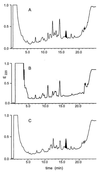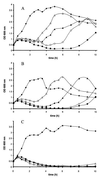Role of the single regulator MrsR1 and the two-component system MrsR2/K2 in the regulation of mersacidin production and immunity
- PMID: 11772616
- PMCID: PMC126572
- DOI: 10.1128/AEM.68.1.106-113.2002
Role of the single regulator MrsR1 and the two-component system MrsR2/K2 in the regulation of mersacidin production and immunity
Abstract
The lantibiotic mersacidin is an antimicrobial peptide of 20 amino acids which inhibits bacterial cell wall biosynthesis by binding to the precursor molecule lipid II and which is produced by Bacillus sp. strain HIL Y-85,54728. The structural gene of mersacidin as well as accessory genes is organized in a biosynthetic gene cluster which is located on the chromosome and contains three open reading frames with similarities to regulatory proteins: mrsR2 and mrsK2 encode two proteins with homology to bacterial two-component systems, and mrsR1 shows similarity to a response regulator. Both mrsR2/K2 and mrsR1 were inactivated by insertion of an antibiotic resistance marker. Disruption of mrsR1 resulted in loss of mersacidin production; however, producer self-protection was not impaired. In contrast, inactivation of mrsR2/K2 led to an increased susceptibility to mersacidin whereas biosynthesis of the lantibiotic remained unaffected. Binding of mersacidin to intact cells was significantly enhanced in the mrsR2/K2 knockout mutant. Reverse transcription-PCR analysis from total RNA preparations showed that in contrast to the wild-type strain, the structural genes of the ABC transporter MrsFGE were not transcribed in the knockout mutant. It was therefore concluded that producer self-protection against mersacidin is conferred by the ABC transporter MrsFGE and that the transcription of mrsFGE is regulated by MrsR2/K2, whereas production of the antibacterial peptide is solely activated by MrsR1.
Figures





Similar articles
-
Biosynthesis of the lantibiotic mersacidin: organization of a type B lantibiotic gene cluster.Appl Environ Microbiol. 2000 Jun;66(6):2565-71. doi: 10.1128/AEM.66.6.2565-2571.2000. Appl Environ Microbiol. 2000. PMID: 10831439 Free PMC article.
-
The lantibiotic mersacidin is an autoinducing peptide.Appl Environ Microbiol. 2006 Nov;72(11):7270-7. doi: 10.1128/AEM.00723-06. Epub 2006 Sep 15. Appl Environ Microbiol. 2006. PMID: 16980420 Free PMC article.
-
Construction of an expression system for site-directed mutagenesis of the lantibiotic mersacidin.Appl Environ Microbiol. 2003 Jul;69(7):3777-83. doi: 10.1128/AEM.69.7.3777-3783.2003. Appl Environ Microbiol. 2003. PMID: 12839744 Free PMC article.
-
Two-component systems regulate ABC transporters in antimicrobial peptide production, immunity and resistance.Microbiology (Reading). 2020 Jan;166(1):4-20. doi: 10.1099/mic.0.000823. Epub 2019 Jun 11. Microbiology (Reading). 2020. PMID: 31204967 Review.
-
The biology of lantibiotics from the lacticin 481 group is coming of age.FEMS Microbiol Rev. 2007 Mar;31(2):134-67. doi: 10.1111/j.1574-6976.2006.00045.x. Epub 2006 Nov 9. FEMS Microbiol Rev. 2007. PMID: 17096664 Review.
Cited by
-
The lantibiotic mersacidin is a strong inducer of the cell wall stress response of Staphylococcus aureus.BMC Microbiol. 2008 Oct 23;8:186. doi: 10.1186/1471-2180-8-186. BMC Microbiol. 2008. PMID: 18947397 Free PMC article.
-
Antimicrobial Peptide Resistance Mechanisms of Gram-Positive Bacteria.Antibiotics (Basel). 2014 Oct 13;3(4):461-92. doi: 10.3390/antibiotics3040461. Antibiotics (Basel). 2014. PMID: 25419466 Free PMC article.
-
Transcription analysis of a lantibiotic gene cluster from Bifidobacterium longum DJO10A.Appl Environ Microbiol. 2011 Sep;77(17):5879-87. doi: 10.1128/AEM.00571-11. Epub 2011 Jul 8. Appl Environ Microbiol. 2011. PMID: 21742926 Free PMC article.
-
Characterization of amylolysin, a novel lantibiotic from Bacillus amyloliquefaciens GA1.PLoS One. 2013 Dec 9;8(12):e83037. doi: 10.1371/journal.pone.0083037. eCollection 2013. PLoS One. 2013. PMID: 24349428 Free PMC article.
-
Identification of a Novel Two-Peptide Lantibiotic from Vagococcus fluvialis.Microbiol Spectr. 2022 Aug 31;10(4):e0095422. doi: 10.1128/spectrum.00954-22. Epub 2022 Jun 22. Microbiol Spectr. 2022. PMID: 35730941 Free PMC article.
References
-
- Bierbaum, G., H. Brötz, K. P. Koller, and H. G. Sahl. 1995. Cloning, sequencing and production of the lantibiotic mersacidin. FEMS Microbiol. Lett. 127:121–126. - PubMed
-
- Breukink, E., C. van Kraaij, R. A. Demel, R. J. Siezen, O. P. Kuipers, and B. de Kruijff. 1997. The C-terminal region of nisin is responsible for the initial interaction of nisin with the target membrane. Biochemistry 36:6968–6976. - PubMed
-
- Brötz, H., M. Josten, I. Wiedemann, U. Schneider, F. Götz, G. Bierbaum, and H. G. Sahl. 1998. Role of lipid-bound peptidoglycan precursors in the formation of pores by nisin, epidermin and other lantibiotics. Mol. Microbiol. 30:317–327. - PubMed
Publication types
MeSH terms
Substances
Associated data
- Actions
LinkOut - more resources
Full Text Sources
Other Literature Sources
Medical
Molecular Biology Databases

